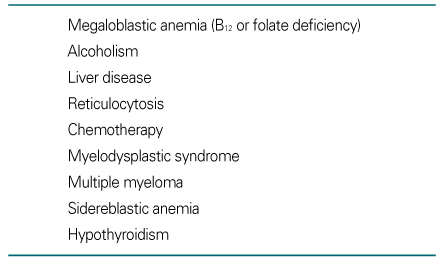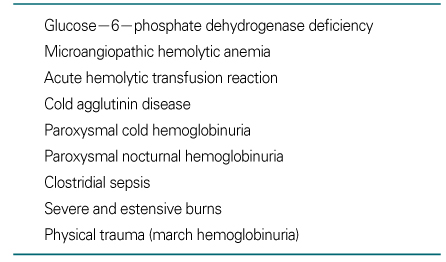 |
 |
- Search
| J Korean Med Assoc > Volume 49(10); 2006 > Article |
Abstract
Anemia is defined as an insufficient amount of RBC mass to adequately deliver oxygen to peripheral tissues. For practical purposes, however, the measurements of three parameters that can be obtained from the complete blood count (CBC) are enough to establish the presence of anemia; hemoglobin (Hb) concentration, hematocrit, and RBC number. Among these, the Hb level is the most convenient parameter to establish the diagnosis of anemia. Anemia is not a disease by itself but mostly a consequence of the underlying acquired or genetic abnormality. Although the clues to the cause of anemia may be found from the history and physical examination, three parameters from CBC provide most critical information for the differential diagnosis of anemia; mean corpuscular volume (MCV), red cell distribution width (RDW), and the reticulocyte count. MCV provides information on the size of the red cell. Values greater than 100 fL usually signify a nuclear maturation defect resulting in macrocytic anemias, while values less than 80 fL are diagnostic of hemoglobin synthesis defect causing microcytic anemias. Meticulous evaluation of the serum iron status and body iron storage is essential to the differential diagnosis of microcytic anemias. RDW is a measure of the red cell size variation. It is increased by the appearance of microcytic or macrocytic cells, or both. The reticulocyte count is a useful laboratory measurement of effective red cell production. Hemolytic anemia or acute bleeding can increase the reticulocyte count. There are four clinically useful laboratory measurements indicating the presence of hemolytic process; the reticulocyte count, the serum bilirubin, the serum lactate dehydrogenase (LDH), and the serum haptoglobin concentration. Once the presence of hemolytic anemia is established, laboratory assessment to differentiate between intravascular and extravascular hemolysis is important because clinical conditions producing intravascular hemolysis may be anticipated in certain clinical situations, which may be complicated by acute renal failure or disseminated intravascular coagulation that needs immediate interventions. If the definitive cause of anemia cannot be established by examining the peripheral blood, a bone marrow study may be helpful.
- TOOLS
-
METRICS

-
- 1 Crossref
- Scopus
- 1,307 View
- 2 Download
-
Related articles in
J Korean Med Assoc -
Pharmacotherapy for patients with Alzheimer’s disease2024 March;67(3)
Diagnosis and treatment of dysphagia2023 October;66(10)
Diagnosis and treatment of trigeminal neuralgia2023 January;66(1)
Management of patients with neuropathic pain2022 August;65(8)
Fertility preservation for patients with cancer2022 June;65(6)










